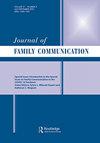Parents’ Management of Privacy Turbulence Surrounding Private, Adoption-Related Information in Transracial, Internationally Adoptive Families
IF 1.8
Q2 COMMUNICATION
引用次数: 3
Abstract
ABSTRACT Parents (N = 166) in transracial, international adoptive (TIA) families with children from China or Vietnam were surveyed to investigate their experiences with privacy turbulence surrounding the family’s private, adoption-related information. About half described at least one instance of privacy turbulence, with a total of 98 instances. The instances included examples of all six types of privacy turbulence described in Communication Privacy Management theory, but two of those types, namely boundary rule mistakes and boundary definition predicaments, accounted for 90% of the instances of turbulence. Evidence of explicit rules and catalyst criteria for rule formation in the turbulence descriptions suggest ways that TIA parents might be able to avoid or manage privacy turbulence.跨种族、国际收养家庭中父母对私人收养相关信息的隐私动荡的管理
本研究调查了166名来自中国或越南的跨种族、国际收养(TIA)家庭的父母,以了解他们在家庭隐私、收养相关信息方面的隐私动荡经历。大约一半的人描述了至少一个隐私动荡的实例,总共有98个实例。这些实例包括通信隐私管理理论中描述的所有六种类型的隐私湍流的例子,但其中两种类型,即边界规则错误和边界定义困境,占湍流实例的90%。湍流描述中明确规则和规则形成的催化标准的证据表明,TIA父母可能能够避免或管理隐私湍流的方法。
本文章由计算机程序翻译,如有差异,请以英文原文为准。
求助全文
约1分钟内获得全文
求助全文

 求助内容:
求助内容: 应助结果提醒方式:
应助结果提醒方式:


